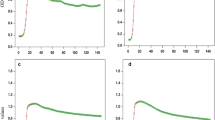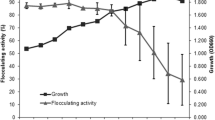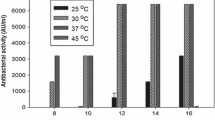Abstract
We have shown previously that in the presence of inducer Bacillus cereus 183, significant increases in bacteriocin production and bactericidal activity of B. thuringiensis occur when the latter is cultivated at pH 7.2, 28°C, and 180 rpm. Here we show that this activity can be further improved when B. thuringiensis is induced with B. cereus 183 and then cultivated with modification of pH, temperature, and agitation. Five native strains of B. thuringiensis, LBIT 269, LBIT 287, LBIT 404, LBIT 420, and LBIT 524 which synthesize, respectively, morricin 269, kurstacin 287, kenyacin 404, entomocin 420, and tolworthcin 524, were cultivated in four different fermentation media. Of these, fermentation in tryptic soy broth (TSB) yielded the highest level of bacteriocin activity (~100–133 FU). Bacteria grown in TSB were induced with B. cereus 183 and cultivated at different pH (6.0, 7.2, 8.0), temperature (26, 28, 30°C), and agitation (150, 180, 210 rpm). Full factorial design was performed and results were analyzed with analysis of variance (ANOVA) and Tukey multiple comparison tests at significant level of α ≤ 0.05 to study the influence of the three variables on bacterial growth and bacteriocin production. Our data show that the highest bacteriocin activity was found with LBIT 269 and LBIT 404 with an increase of ~95–100% compared with induced B. thuringiensis strains cultivated under fixed conditions (pH 7.2, 28°C, 180 rpm), for which the data were set at 0%. The optimal conditions for morricin 269 and kenyacin 404 production were, respectively, pH 8, 30°C, 210 rpm and pH 7.2, 26°C, 210 rpm.


Similar content being viewed by others
References
Barboza-Corona JE, Vázquez-Acosta H, Bideshi D, Salcedo-Hernández R (2007) Bacteriocin-like inhibitor substances production by Mexican strains of Bacillus thuringiensis. Arch Microbiol 187:117–126
Besson F, Chevenet C, Michel G (1987) Influence of the culture medium on the production of iturin A by Bacillus subtilis. J Gen Microbiol 133:767–772
Bhunia AK, Johnson MC, Ray B (1988) Purification, characterization and antimicrobial spectrum of bacteriocin produced by Pediococcus acidilactici. J Appl Microbiol 65:261–268
Black JG (1999) Microbiology: principles and explorations, 4th edn. Wiley, New York
Calderon-Santoyo M, Mendoza-García PG, García-Alvarado MA, Escudero-Abarca BI (2001) Effecto of physical factors on the production of bacteriocin from Pediococcus acidilactici ITV 26. J Ind Microbiol Biotechnol 26:191–195
Callewaert R, De Vuyst L (2000) Bacteriocin production with Lactobacillus amylovorus DCE 471 is improved and stabilized by fed-batch fermentation. Appl Environ Microbiol 66:606–613
Cardoso-Fontes G, Fonseca-Amaral PF, Nele M, Zarur-Coelho MA (2010) Factorial design to optimize biosurfactant production by Yarrowia lipolytica. J Biomed Biothech 821306. doi:10.1155/2010/821306
Casique-Arroyo G, Bideshi D, Salcedo-Hernández R, Barboza-Corona JE (2007) Development of a recombinant strain of Bacillus thuringiensis subsp. kurstaki HD-73 that produces the endochitinase ChiA74. Antonie van Leeuwenhoek 92:1–9
Castañeda-Ramírez C, Cortes-Rodríguez V, de la Fuente-Salcido N, Dennis K, Bideshi DK, Barboza-Corona JE (2011) Isolation of Salmonella spp. from lettuce and evaluation of its susceptibility to novel bacteriocins synthesized by Bacillus thuringiensis and antibiotics. J Food Protect 74:274–278
Chiegh CI, Choi HJ, Park H, Kim SB, Kook MC, Kim TS, Hwang JK, Pyum YR (2002) Influence of growth conditions on the production of a nisin-like bacteriocins by Lactococcus lactis subsp. lactis A 164 isolated from kimchi. J Biotechnol 95:225–235
De la Fuente-Salcido N, Alanís-Guzmán MG, Bideshi DK, Salcedo-Hernández R, Bautista-Justo M, Barboza-Corona JE (2008) Enhanced synthesis and antimicrobial activities of bacteriocins produced by Mexican strains of Bacillus thuringiensis. Arch Microbiol 190:633–640
De la Fuente-Salcido N, Salcedo-Hernández R, Alanis-Guzmán MG, Bideshi DK, Barboza-Corona JE (2007) A new rapid fluorogenic method for measuring bacteriocin activity. J Microbiol Methods 70(1):196–199
De Vuyst L, Vandamme EJ (1992) Influence of the carbon source on nisin production in Lactococcus lactis subsp. lactis batch fermentations. J Gen Microbiol 138:571–578
Jan J, Valle F, Bolivar F, Merino E (2001) Construction of protein overproducer strains in Bacillus subtilis by an integrative approach. Appl Microbiol Biotechnol 55:69–75
Kamoun F, Zouari N, Saadaoui I, Jaoua S (2009) Improvement of Bacillus thuringiensis bacteriocin production through culture conditions optimization. Prep Biochem Biotech 39:400–412
Khalil R, Djadouni F, Elbahloul Y, Omar S (2009) The influence of cultural and physical conditions on the antimicrobial activity of bacteriocin produced by a newly isolated Bacillus megaterium 22 strain. Afr J Food Sci 3:11–22
Kim MH, Kong YJ, Baek H, Hyun HH (2006) Optimization of culture conditions and medium composition for the production of micrococcin GO5 by Micrococcus sp. GO5. J Biotechnol 121:54–61
Leroy F, De Vuyst L (1999) Temperature and pH conditions that prevail during fermentation of sausages are optimal for production of the antilisterial bacteriocin sakacin K. Appl Environ Microbiol 65:974–981
López JE, Ochoa A, Santoyo G, Anaya JL, Medina E, Martpinez M, Loeza PD (2008) Bacteriocins of gram positive bacteria: a potential source of new biomedical treatments. Rev Mex Cien Farm 39:49–57
Lou Y, Yousef AE (1997) Adaptation to sublethal environmental stresses protects Listeria monocytogenes against lethal preservation factors. Appl Environ Microbiol 63:1252–1255
Messens W, Neysens P, Vansieleghem W, Vanderhoeven J, De Vuyst L (2002) Modeling growth and bacteriocin production by Lactobacillus amylovorus DCE 471 in response to temperature and pH values used for sourdough fermentations. Appl Environ Microbiol 68:1431–1435
Ozkan M, Dilek FB, Yetis U, Uzcengiz G (2003) Nutritional and cultural parameters influencing antidipteran delta-endotoxin production. Res Microbiol 154:49–53
Park HW, Delécluse A, Federici BA (2001) Construction and characterization of a recombinant Bacillus thuringiensis subsp israeliensis strain that produces Cry11B. J Invertebr Pathol 78:37–44
Tabbene O, Slimene IB, Djebali K, Mangoni ML, Urdaci MC, Limam F (2009) Optimization of medium composition for the production of antimicrobial activity by Bacillus subtilis B38. Biotechnol Prog 25:1267–1274
Acknowledgments
This research was supported partially by grants 104/08 and 82317 to JEB-C from Universidad de Guanajuato and CONACYT Mexico, respectively. We thank Dr. Mauricio Valencia Posada from Universidad de Guanajuato for his help with the statistical analysis, and Leticia Castro-Barrita for her technical assistance.
Author information
Authors and Affiliations
Corresponding author
Rights and permissions
About this article
Cite this article
Martínez-Cardeñas, J.A., de la Fuente-Salcido, N.M., Salcedo-Hernández, R. et al. Effects of physical culture parameters on bacteriocin production by Mexican strains of Bacillus thuringiensis after cellular induction. J Ind Microbiol Biotechnol 39, 183–189 (2012). https://doi.org/10.1007/s10295-011-1014-8
Received:
Accepted:
Published:
Issue Date:
DOI: https://doi.org/10.1007/s10295-011-1014-8




